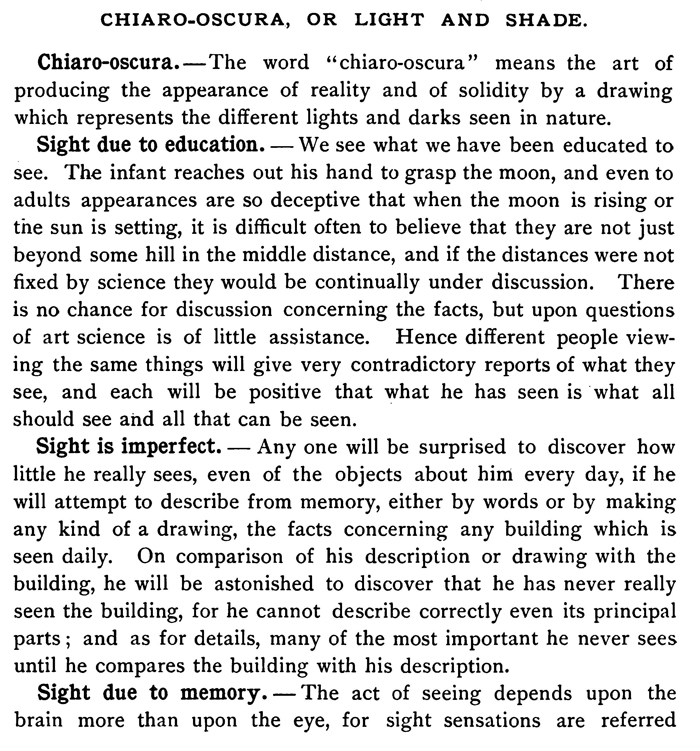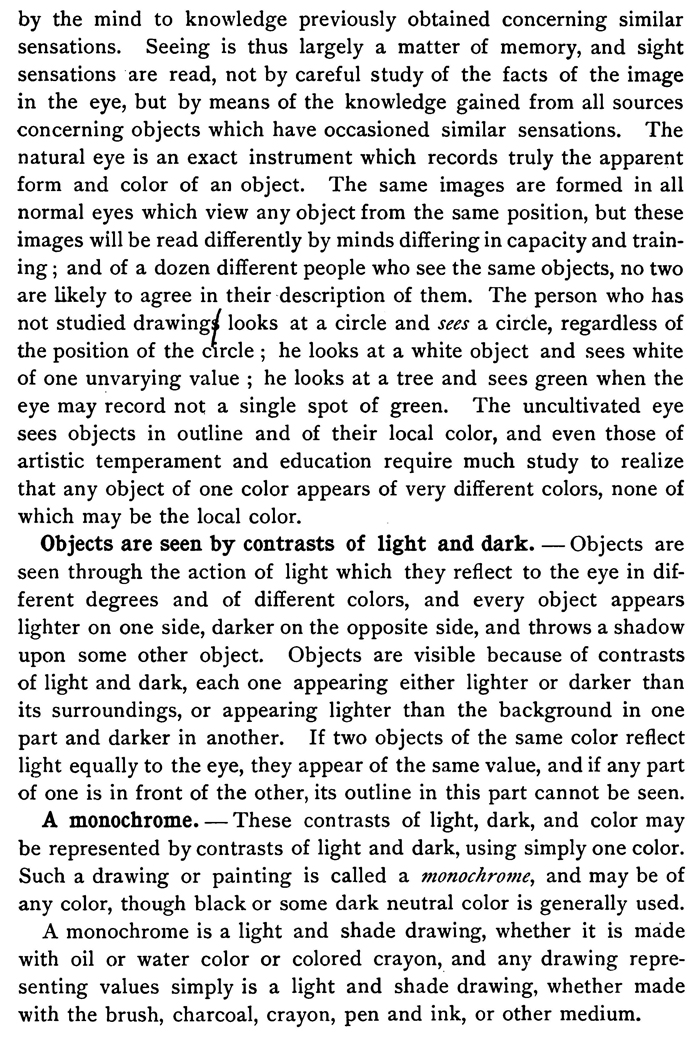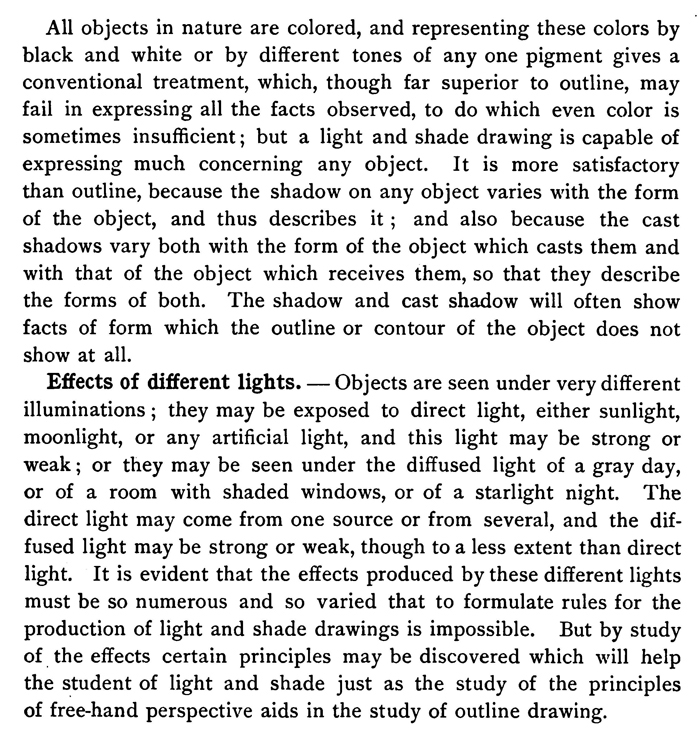Home > Directory of Drawing Lessons > How to Improve Your Drawings > Drawing Lights and Shadows > Drawing and Seeing Lights and Shadows
How to Draw & See Shadows and Lights with the Following Drawing, Lighting & Shading Lesson
|
|
CHIARO-OSCURA, OR LIGHT AND SHADE.Chiaro-oscuraThe word "chiaro-oscura" means the art of producing the appearance of reality and of solidity by a drawing which represents the different lights and darks seen in nature. Sight due to education.We see what we have been educated to see. The infant reaches out his hand to grasp the moon, and even to adults appearances are so deceptive that when the moon is rising or the sun is setting, it is difficult often to believe that they are not just beyond some hill in the middle distance, and if the distances were not fixed by science they would be continually under discussion. There is no chance for discussion concerning the facts, but upon questions of art science is of little assistance. Hence different people viewing the same things will give very contradictory reports of what they see, and each will be positive that what he has seen is what all should see and all that can be seen. Sight is imperfect.Any one will be surprised to discover how little he really sees, even of the objects about him every day, if he will attempt to describe from memory, either by words or by making any kind of a drawing, the facts concerning any building which is seen daily. On comparison of his description or drawing with the building, he will be astonished to discover that he has never really seen the building, for he cannot describe correctly even its principal parts ; and as for details, many of the most important he never sees until he compares the building with his description. Sight due to memory.The act of seeing depends upon the brain more than upon the eye, for sight sensations are referred by the mind to knowledge previously obtained concerning similar sensations. Seeing is thus largely a matter of memory, and sight sensations are read, not by careful study of the facts of the image in the eye, but by means of the knowledge gained from all sources concerning objects which have occasioned similar sensations. The natural eye is an exact instrument which records truly the apparent form and color of an object. The same images are formed in all normal eyes which view any object from the same position, but these images will be read differently by minds differing in capacity and training ; and of a dozen different people who see the same objects, no two are likely to agree in their description of them. The person who has not studied drawing looks at a circle and sees a circle, regardless of the position of the c rcle ; he looks at a white object and sees white of one unvarying value ; he looks at a tree and sees green when the eye may record not a single spot of green. The uncultivated eye sees objects in outline and of their local color, and even those of artistic temperament and education require much study to realize that any object of one color appears of very different colors, none of which may be the local color. Objects are seen by contrasts of light and dark.Objects are seen through the action of light which they reflect to the eye in different degrees and of different colors, and every object appears lighter on one side, darker on the opposite side, and throws a shadow upon some other object. Objects are visible because of contrasts of light and dark, each one appearing either lighter or darker than its surroundings, or appearing lighter than the background in one part and darker in another. If two objects of the same color reflect light equally to the eye, they appear of the same value, and if any part of one is in front of the other, its outline in this part cannot be seen. A monochrome.These contrasts of light, dark, and color may be represented by contrasts of light and dark, using simply one color. Such a drawing or painting is called a monochrome, and may be of any color, though black or some dark neutral color is generally used. A monochrome is a light and shade drawing, whether it is made with oil or water color or colored crayon, and any drawing representing values simply is a light and shade drawing, whether made with the brush, charcoal, crayon, pen and ink, or other medium. All objects in nature are colored, and representing these colors by black and white or by different tones of any one pigment gives a conventional treatment, which, though far superior to outline, may fail in expressing all the facts observed, to do which even color is sometimes insufficient ; but a light and shade drawing is capable of expressing much concerning any object. It is more satisfactory than outline, because the shadow on any object varies with the form of the object, and thus describes it ; and also because the cast shadows vary both with the form of the object which casts them and with that of the object which receives them, so that they describe the forms of both. The shadow and cast shadow will often show facts of form which the outline or contour of the object does not show at all. Effects of different lights.Objects are seen under very different illuminations ; they may be exposed to direct light, either sunlight, moonlight, or any artificial light, and this light may be strong or weak ; or they may be seen under the diffused light of a gray day, or of a room with shaded windows, or of a starlight night. The direct light may come from one source or from several, and the diffused light may be strong or weak, though to a less extent than direct light. It is evident that the effects produced by these different lights must be so numerous and so varied that to formulate rules for the production of light and shade drawings is impossible. But by study of the effects certain principles may be discovered which will help the student of light and shade just as the study of the principles of free-hand perspective aids in the study of outline drawing. |
Privacy Policy ...... Contact Us







